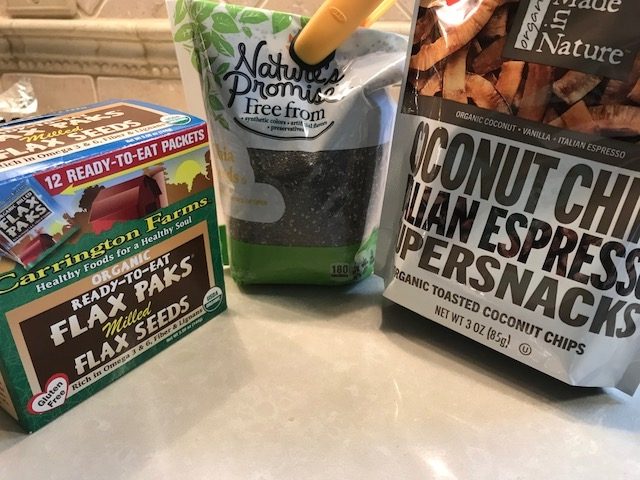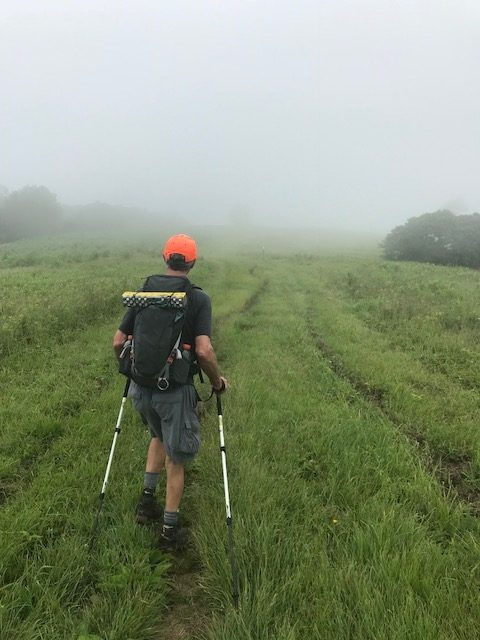Keto on the Trail: Hiking Through High-Carb Territory
I never expected our hike to turn into an endless search for avocados. I thought that resupplying would be a breeze, that local diners and grocery stores would have plenty of keto-friendly foods we could eat as we worked our way down the trail. Man, was I ever wrong.
My husband and I came to the low-carb way of eating fairly recently. After our attempted thru-hike last year, we predictably regained the weight wed lost. The cause wasnt anything mysterious, just our suddenly sedentary lifestyle combined with a reluctance to restrict our appetites (being able to eat whatever you want on the trail is fun). But along with the unwanted weight, we both developed serious medical issues we needed to address. So, taking our doctors advice, we decided to go low-carb.
The theory behind low-carb eating makes sense if youre a hiker. By restricting your carbohydrate intake, you force your body into ketosis, i.e., fat-burning mode. This is exactly what happens on a thru-hike when your body cant keep up with the energy demands; it uses your fat for fuel. So by following a low-carb diet wed be replicating our experience on the trail — but without the grueling hike.
It sounded great and worked even better. We instantly dropped the weight. Our health immediately improved. (My painful bursitis disappeared, and my husband got off his blood pressure and cholesterol meds.) We were sold. The Standard American Diet (SAD) became history in our house. We were committed to following the low-carb way of eating long-term.
But as we prepared to return to the trail, we had a couple of questions. First, did we need more carbohydrates for energy while hiking? And secondly, exactly what were we going to eat?
The answer to the first question turned out to be no. Studies show that once an athletes body is fully keto-adapted, fat works as well or better than carbs for fuel. There is no need to carbo-load. You dont need those raisins and M&Ms. (And our experience bore this out. We had no problems with hunger or fatigue during our hike despite our limited carbs.)
The second question was more difficult, but since we were doing this section with car support, we didnt need to worry about weight. We just needed quick, easy, non-cook food we could store in our coolers and stay within the 20-50 carbs per day range. We settled on the following foods:
Breakfast: deli meat and cheese, avocado, precooked bacon, tomatoes, coffee or tea.
Snacks on the trail: assorted nuts (with coconut thrown in to add interest), Manchego cheese, hard sausage, low-carb protein bars, electrolyte drinks.
Dinner: canned tuna or chicken, healthy mayonnaise, more avocados, olives, tomatoes, flax and chia seeds, blueberries and cream.
Since we had cars, we expected to eat dinners out whenever possible to break the monotony of our diet and fill in the missing gaps.
Unfortunately, it didnt work out that way. It seems theres an appalling lack of low-carb options in rural America, which is ironic. Back in my grandparents day, high-fat eating was the norm, especially in little towns. Meals consisted of fresh vegetables (usually homegrown), free-range, grass-fed everything, all slathered with plenty of fat. But in the last two generations American food has changed drastically. Everything is now processed, devoid of healthy fat, and filled with sugar and starch.
And every place was the same local diners, chain restaurants, it didnt matter. Everything came breaded and served with potatoes. We couldnt find a dish without carbs. Organic beef? Spinach salad? There wasnt a chance. (And there are only so many hamburgers I can eat without a bun.)
Which is how we found ourselves on an endless quest for avocados, searching in vain through piles of overripe fruit in every small-town market we could find. It wasnt just daunting. It was darned near impossible. There didn’t seem to be anything we could eat.
And after several weeks without variety, we became thoroughly sick of our food. I began regarding my cheese with loathing. The sight of my sausage made my stomach turn. And I could barely choke down those avocados, a food I have always loved. We were more than bored, we were losing our appetites — which we definitely couldnt afford.
So now were back home, gearing up for the next phase of our hike — and I need ideas. If you follow a keto/Atkins/low-carb diet, Id love your input. Any suggestions about what we might take on the trail? Because pizza and subs aren’t an option, even if we are hiking through a low-carb wasteland. Keto works. We aren’t abandoning our diets. But we desperately need to vary our meals.
This website contains affiliate links, which means The Trek may receive a percentage of any product or service you purchase using the links in the articles or advertisements. The buyer pays the same price as they would otherwise, and your purchase helps to support The Trek's ongoing goal to serve you quality backpacking advice and information. Thanks for your support!
To learn more, please visit the About This Site page.






Comments 13
Hi Gail,
As a newbie to Keto life and a 2019 AT thru-hiker, I too am worried about food on the trail.
Since you have access to coolers can you use prepared guacamole instead of whole avocados? Boiled eggs, turkey jerky?
Im sketching out my menu and trying different options while in the land of a/c and grocery stores. I plan to heat water, so that adds dehydrated and powdered foods to my options.
Would love to keep in contact so we can bounce ideas back and forth.
HYOH
Shirley
Hi Shirley. Guacamole is a great idea, and I’ll add that to my list. Part of the problem, though, is that even with car support, refrigerated food only lasts so long. Then I’m back to resupplying from stores in little towns, which has proven to be hard. I didn’t worry about eggs this trip because I assumed (wrongly) that we’d be able to find omelettes easily enough. Unfortunately, we were always on the trail by breakfast time, and we couldn’t find many restaurants that would serve omelettes for dinner (Mojos in Damascus did, but it was an exception). There weren’t any IHOPS where we were. I’ve been looking at jerky but haven’t found any that is sugar-free. And I just found out that sausage contains gluten, so we probably need to limit that… This is frustrating, but I’m determined to find a way through. I’d love to keep in touch, so if you discover anything, let me know!!!!
We make a delicious dried sausage called jagerwurst that is gluten-free. It does contain a little sugar . It is delicious! Working on a sugar free formulation. And we do ship
Ive been looking for gluten free sausage. How does it hold up in the heat?
Oh, I should add that a couple of the hotels we stayed in included breakfast, and if our hike wasn’t too long that day we waited for that. But I doubt the eggs they served are real. I’m sure they are reconstituted, so who knows what else they contain.
I have been keto for 2+ years. These are what I take. Cured meats such as bacon, country ham, salami pepperoni. Fresh eggs (in shell). Pemmican or you can brown ground beef and incase in butter, won’t be as stable long term as pemmican but I have kept it for a week. Canned or pouch meats and mayo packets. Trail side ham salad is great. Olive oil. Jerky. The best option is intermittent and extended fasting. People will think you are crazy but your food bag will be lighter than everyone else’s.
Thanks for the suggestions, Bill. Where do you get your pemmican? I love the idea of intermittent fasting because of the benefits to the brain. I’ve been trying it at home (6-18), but I have trouble getting enough calories and protein in just six hours and find that I lose too much weight. Has your weight stabilized?
i have made the pemmican. i prefer the ground beef and butter. my weight has plateaued. I Still have a bit to lose.
Thanks, Bill. I’ll look up some recipes. One thing I love about keto is that I don’t get as hungry while hiking. My blood sugar remains stable throughout the day, so it seems I don’t need to eat as much, and I still have energy. Unfortunately, I do have to be careful not to lose too much weight. I don’t mind being skinny, but I don’t want to look skeletal. But that’s a problem regardless of diet. Last year on our attempted thru-hike I got very thin while eating carbs, so that’s not the cause. I just have to be careful that I don’t get bored with my food and eat even less when my energy expenditure is so great. I appreciate the suggestions so I can mix things up.
You can buy any protein freeze dried in #10 cans so you can make up your own freeze dried meal packets: freeze dried eggs and sausage, onions peppers, bacon; freeze dried bone broth w/ meat and veg, Keto gravy, meat, w/LC veg, etc. Carry plastic bottles olive oil, coconut oil. Make your own fat bomb bars using coconut oil, whey,, collagen, stevia, cocoa powders, flavorings, ground nuts, freeze dried berries 300-600 calories each. Use Indian spices or dehydrated cream base for dehydrated spinach, green beans, sausage gravy, etc. Make your own green drink protein powder concoctions w/spinach powder, spirilina, kale, whey, peanut butter powder. Get squeezable natural peanut or nut butter packets. Dehydrated bone broths. Pick up fresh veg, fruit or berries in town, make sure they have hard exteriors, cucumber, unripe tomato, apples, oranges etc, or pack in sealed rigid plastic containers or bubble wrap. Dried meats, salami, jerky, meat sticks, or packets, such as tuna, or salmon, or any nuts you like, hard cheeses or cheese sticks. Some people eat the same thing every day for breakfast, lunch and dinner on the trail, but eat like crazy on town stops. There’s no reason why you couldn’t order a pizza or a sandwich or taco and pile everything but the bread/tortilla onto a salad with a fat or dairy based dressing. Also, ask for extra cheese often, and order sandwiches protein style with a lettuce wrap instead of bread, buns, or tortilla (very common to do this these days). Many proprietors will accommodate that kind of request. Thru hikers often eat all the butter pats or oil dressings they can get when they eat in towns, and then ask for extra, & order extra side dishes of veggies/salads. You can also find coconut based wraps and carry those with you.
Thank you so much! This is exactly the information I was looking for. I’ll check for the dehydrated things, especially, right away.
Oh, and I forgot to add, fats will not take you out of ketosis, but if you’re practicing Intermittent Fasting, and consume meats, the protein stops curative autophagy that would kick in after about 24-48 hours of fasting in most people, although it sometimes takes longer than 2 days to kick in. You would still get IF blood sugar results by not eating for a shorter period of time though. The key would be to consume as much fats as possible so your body doesn’t cannibalizes its own fat stores, and then you’d end up not losing so much weight. Dr Mercola makes Ketogenic diet enzymes, named Ketozyme, to help the body assimilate fats and nutrients, especially good for those of us in the 50+ range doing LCHF.
Right, the protein would convert to glucose, correct? So far I’ve only done the 16/8 type intermittent fasting, but never while hiking.